#by Carol Winkler
Explore tagged Tumblr posts
Text
Christmas Carol-cember Day 4
From the executive producer behind “The Stepford Wives” and “The Taking of Pelham One Two Three,” Edgar Scherick brought to audiences in December 1979 this oft-forgotten adaptation of the Charles Dickens novel that moved the setting from 1840s London to 1930s New England for ABC Television network titled "An American Christmas Carol."
Naturally, since this TV Movie rarely got as much replay on cable as often as other Christmas specials, this one almost passed me by until I found it on IMDB. Though I admit it wasn’t the fact this was an American take on the story that caught my eye but it’s lead star: Henry Winkler.
Yes, the Fonz himself, is our Scrooge.

Benedict Slade, Henry Winkler under old man makeup crafted by makeup legend Rick Baker, is a miserly old man whose wrinkles could count the many people whose homes and property he has repossessed over their debts while refusing to reopen the granite mines that use to provide for the workers in town. Made worse that the country is in the midst of an economic depression, he’s stepped up his repossession efforts and stuffed them all in a warehouse where he intends to sell off the meager possessions to collect a sum, including tearing the leather linings to a copy of a certain Charles Dickens’ book.
But as it just so happens, he finds himself haunted by three ghosts, each one manifesting in the form of people he repossessed who show him visions of the past as an isolated orphan and how the cut-throat tactics of the business world molded him and cost him the life he could have lead. Visions of the present where said lost love, Susan Hogan, is clearly happier without him and the hard strife from his employee that impacts his ill son and a vision of the future where his cruelty results in the painful death of this child and the populace coming to repossess all he ever owned, only to burn it all while leaving his grave littered with overgrowth.
Even for American television, Eric Till’s direction is solid with the limitations he has at his disposal. The suspense that builds when Slade’s warehouse loses power and he realizes someone is in there with him before his former partner, Ken Pogue, just reveals himself casually with “Are you really gonna shoot your old partner?”
No big wail or chains to rattle, but the sudden appearance is sudden yet he he feels very inviting. Stuff like that really makes this version more engaging with its subtlety than other versions I’ve seen.
I like that the ghosts are each represented by people Slade personally met who are haunting him and they don’t necessarily declare themselves to be ghosts but just let Slade make that distinction. When he sees the Ghost of Christmas Past, played by David Wayne, in his warehouse playing a trumpet and lamenting his time playing in the Army and Slade asks if that is who he is, the figure just replies “you said it, not me.”
Or when the owner of the orphanage, Gerard Parkes, is addressed as the Ghost of Christmas Present, he only responds “you have a very interesting way of things.”
Even the choice to make the Ghost of the Future dress like he is from the 70s and allowing him to speak instead of being silent is a unique choice. Course even when he speaks, you hang on every word he says, for the few he provides as he just lets the images speak for themselves.
And then there’s Henry Winkler as Benedict Slade.
His performance surprised me.
youtube
There’s something fascinating about what he does with this performance of Scrooge that I’ve rarely seen in other performances.
Given Winkler was best known for playing Fonzie, it’s such a radical departure to see him go from the cool customer to this raspy grouch who views people as trying to interfere with his success.
There’s almost something subdued about what he’s doing with the character, someone who tries to justify all his coldness as reasonable business ventures, only for him to see how his choices negatively impact others around him. In a way, it makes him more realistic as a character, especially given the slate of billionaires in this country who spout business theories to validate their business tactics for their success, even if it means leaving others to suffer for their wealth.
But even when Slade undergoes his change, he’s still a bit rough around the edges, totally awkward even as he genuinely tries to come off as a changed man but he hasn’t exactly made that shift. The final line he gives to this orphaned kid he decides to adopt as he sees something of himself in the youth really encapsulates that as he tells the kid who is uncertain whether he wants to live with Slade “Give it a chance…give me a chance.”
It’s a profound line and one that clearly demonstrates that this is a Scrooge who has a lot to work on. Which feels genuine to me, as someone who has undergone therapy, people aren’t able to magically shift or change overnight but it takes commitment to grow and change yourself to be the best version of yourself that honors your trauma and works to be the best version of yourself that benefits everyone, not just yourself.
“An American Christmas Carol” is a surprising find. A version I had not heard of until I was doing this challenge and I’m legitimately glad I found it. It showcases a more subtle performance of Scrooge by Henry Winkler, who not only rises to the occasion but meets it, as well as taking advantage of some surprising changes that really makes this version stand on it’s own two feet.
It does have the occasional corny moment, but I personally found it charming. This is a hidden gem of a Christmas movie that’s worth checking out. Especially as Shout Factory has brought the film to physical media for others to enjoy it.
Also, how you know this is an American version?
When the Jacob Marley character shows up to haunt Slade, Slade pulls out a shotgun.
Definitely American. XD

“An American Christmas Carol” is available to stream on YouTube, Amazon Prime, and Peacock.
Next up, a woman is Scrooge? How does that work? Well it won't leave a "hallmark" if you ask me.

#christmas#ebenezer scrooge#a christmas carol#reviews#christmas carol#henry winkler#American Christmas Carol#made for tv movie#Youtube
3 notes
·
View notes
Text

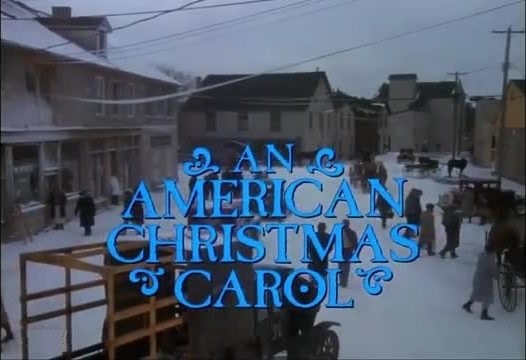
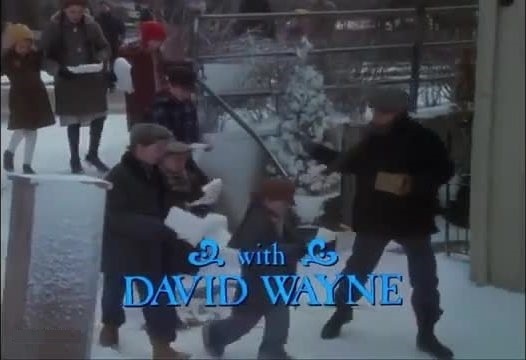

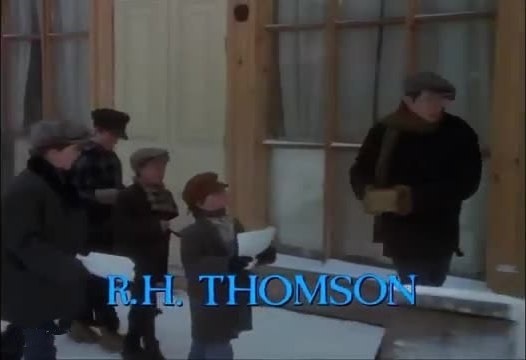

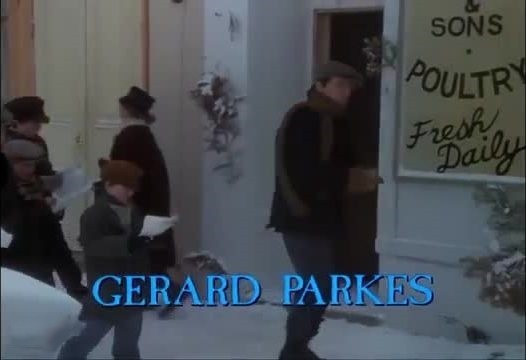
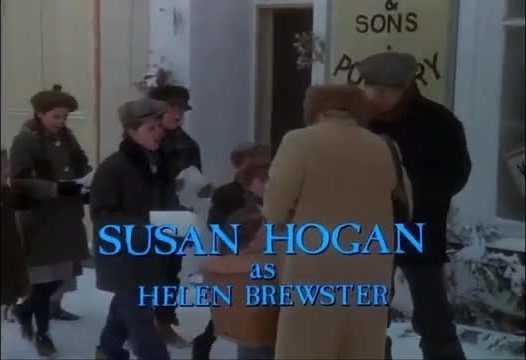

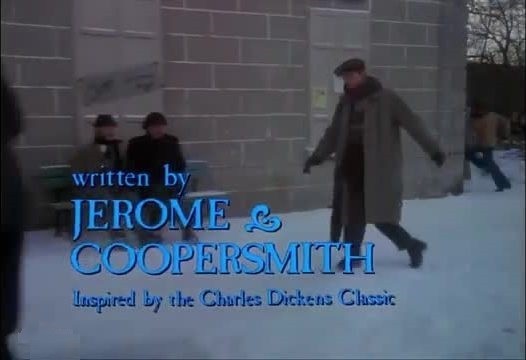
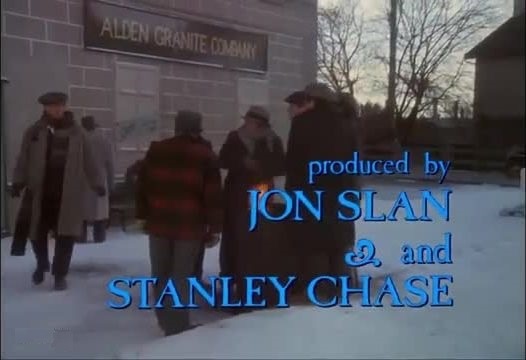
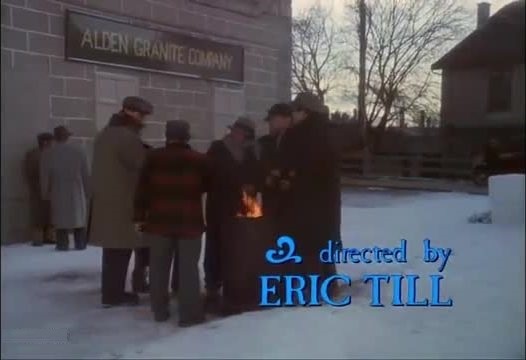

An American Christmas Carol - ABC - December 16, 1979
Christmas Drama / Fantasy
Running Time: 97 minutes
Stars:
Henry Winkler as Benedict Slade
Dorian Harewood as Matt Reeves
Susan Hogan as Helen Brewster
Cec Linder as Auctioneer
R.H. Thomson as Thatcher
David Wayne as Merrivale
Michael Wincott as Choir Leader
William Bermender as Orphan
Brett Matthew Davidson as Orphan
Tammy Bourne as Sarah Thatcher
Chris Cragg as Jonathan Thatcher
James B. Douglas as Sam Perkins
Arlene Duncan as Jennie Reeves
Linda Goranson as Mrs. Doris Thatcher
Gerard Parkes as Jessup
Mary Pirie as Mrs. Brewster
Kenneth Pogue as Jack Latham
Sammy Snyders as Young Slade
Chris Wiggins as Mr. Brewster
Alexander Galant as Orphan (uncredited)
#An American Christmas Carol#TV#ABC#Christmas#Drama#1979#1970's#Henry Winkler#Dorian Harewood#Susan Hogan#David Wayne#Chris Wiggins#R H Thomson#Kenneth Pogue#Gerald Parkes
9 notes
·
View notes
Text
youtube
It’s true. Back in the seventies, they did a made-for-TV version of A Christmas Carol starring The Fonz (Henry Winkler), and it’s the best one ever.
#fonzie#the fonz#henry winkler#an american carol#a christmas carol#slade>scrooge#i think he deserves another shot at the role#Youtube
0 notes
Text


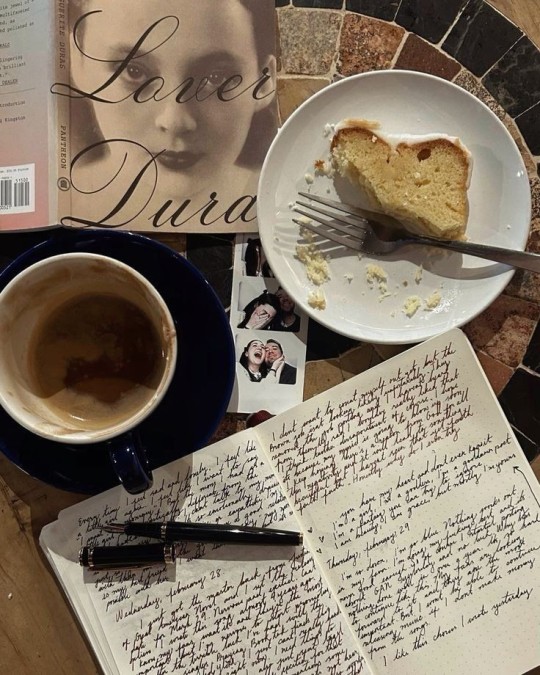
❥﹒♡﹒☕﹒ 𝘆𝗼𝘂 𝗻𝗲𝗲𝗱 𝘁𝗼 𝘀𝘁𝗲𝗽 𝗶𝗻𝘁𝗼 𝘁𝗵𝗲 𝗿𝗼𝗼𝗺 𝘄𝗵𝗲𝗿𝗲 𝘆𝗼𝘂'𝗿𝗲 𝗻𝗼𝘁 𝘁𝗵𝗲 𝗯𝗲𝘀𝘁
you have a choice. you can stay in the room where you are the best, where people rely on you, turn to you to learn, to improve. you can satisfy your ego and bask in the awareness that no one is above you.
or you can step into the room where you are not the best — where, in fact, you might be the worst at what you do. you can finally realize that there will always be someone better than you, humble yourself, cry, and wallow in self-pity.
you can remain in the room where you are praised and admired, or you can surround yourself with people who are better and more experienced than you. you can accept that there’s still a long way to go, that your talent and effort are nowhere near enough, and struggle to keep up with those who are truly better than you. then — and only then — you can unlock your true potential.
it is only by believing you’re far behind others that you’ll improve more than you ever thought possible.
why discomfort breeds growth
studies show that we grow most when we step outside of our comfort zones. according to a study published in the « journal of experimental psychology », being exposed to challenging and unfamiliar tasks increases brain plasticity, the brain's ability to adapt and develop new neural pathways. when you’re the “worst” in the room, your brain is forced to engage, learn, and adapt — activating areas responsible for problem-solving and critical thinking.
the “zone of proximal development”
lev vygotsky, a developmental psychologist, introduced the concept of the "zone of proximal development" (zpd) — the sweet spot where tasks are just beyond your current abilities. learning happens most effectively within this zone, but only if you're willing to confront challenges head-on. surrounding yourself with people who are more skilled or experienced than you puts you directly into this zone.
embracing failure as a learning tool
a 2011 study by ayelet fishbach and lauren eskreis-winkler, published in the journal of experimental social psychology, highlighted that experiencing failure can actually improve motivation and learning. the researchers found that when individuals interpret failure as an opportunity to learn rather than a threat to their ego, they develop greater resilience and determination in achieving their goals. this approach transforms the initial discomfort of not being the best into a powerful driver for personal growth.
how to start stepping into the “hard” rooms
adopt a growth mindset: psychologist carol dweck's research highlights the power of a growth mindset — believing that skills and intelligence can improve with effort. view every setback as an opportunity to learn.
reframe comparisons: instead of feeling inadequate when others outperform you, see them as resources. ask questions, learn from their methods, and let their expertise challenge you.
set stretch goals: aim for targets that feel slightly out of reach. they should scare you just enough to make you uncomfortable — but also excited to try.
stepping into the room where you’re not the best is scary. it might hurt your pride. but science is clear: true growth comes from struggle, humility, and persistence. the next time you feel like you're the worst in the room, remember — you're in the perfect place to unlock your potential.
guys i really hope this makes sense because my english is broken this days. also it's exam season, so i'm taking my exams in spanish. my brain seems settled on my third language and i can't easily switch back to english. this days i can't even speak italian properly ush.
#college#education#school#academia#student#study aesthetic#study blog#study inspiration#study motivation#note taking#growth#growth mindset#self love affirmations#self improvement#self care#self love#academic overachiever#dark academia#academic weapon#academic validation#study abroad#exchange student#student life#studying#study community#study hard#study notes#study space#study tips#studyblr
169 notes
·
View notes
Text
youtube
Earlier this month Modesto, California hosted The American Graffiti Festival and Car Show.

A celebration of the George Lucas movie and a fundraiser for charities, the event kicked off with a parade of classic cars on the historical 10th and 11th Streets that inspired the film.

While the festival and car show celebrated its 24th anniversary, 2023 marks the 50th anniversary of American Graffiti.
Last year Mackenzie Phillips had to cancel her appearance, but she was able to attend this year.

In her first acting role ever at only 12 years old, Mackenzie portrayed Carol Morrison in the movie that starred Ron Howard (who would later be on Happy Days alongside So Weird's future executive producer Henry Winkler), Candy Clark, Richard Dreyfuss, Harrison Ford, and other now-recognizable names.

One of two stars who attended this year's festival, Mackenzie was the only woman of the six inductees to the Legends of the Cruise Walk of Fame.

She was escorted through the route and received a plaque at an onstage ceremony before mingling with the crowd to sign autographs, take photos, and hang out with car enthusiasts.
Thanks for the tip, Jimmie!
#mackenzie phillips#molly phillips#american graffiti#so weird#so weird disney#disney so weird#candy clark#henry winkler#harrison ford#ron howard#richard dreyfuss#modesto#modesto california#car show#american graffiti car show#george lucas#festival and car show#youtube#Youtube
5 notes
·
View notes
Text
My thoughts as I‘m watching 24 seasons of law &order svu:
Season 3
Was curious to see how/if they‘d address 9/11. So I wasn‘t surprised that they changed the intro to no longer show the twin towers.
Capt. Cragen playing the video game and telling them all how he played it. Sounds so proud of himself.
Fascinating shot in the beginning of 3x15, the rapist‘s face is better light than Elliot’s making Elliot look like the bad guy.
Most relatable thing: the fact that Benson wears the same top in different colors for several episodes over the season.
3x16, I have a bit of a problem with patient confidentiality (or rather lack there of). I mean, it‘s pretty normal to tell loved ones about patients, but Kathy gave Elliot waaaayyy too much information. I mean the sex is a given, but the age, family history (even if only small) as well as the school she attends. Makes it pretty easy to figure out. She could have just said an underage girl got raped. And left it at that. Elliot didn‘t really help either. I did like how Nurse Carol shut him down though! And that they addressed the dubious gathering of information.
Familiar faces: Rachel's father from friends, Liza Weil, Elizabeth Banks, Jimmy from OTH, Paige Turco(!!!), One of the kids from Music of the Heart, Nurse Eli from Grey‘s, Emily Deschanel, Henry Winkler, Clara from Back to the Future and last but not least: Eric Stoltz
Favorite episodes: 3x02 (protective Elliot), 3x10 (was wondering when they would get to a case where a woman raped a man) and 3x19.
Favorite quote: „Dad‘s Mad.“ -Fin 3x18
4 notes
·
View notes
Text
March 1939: Just Married
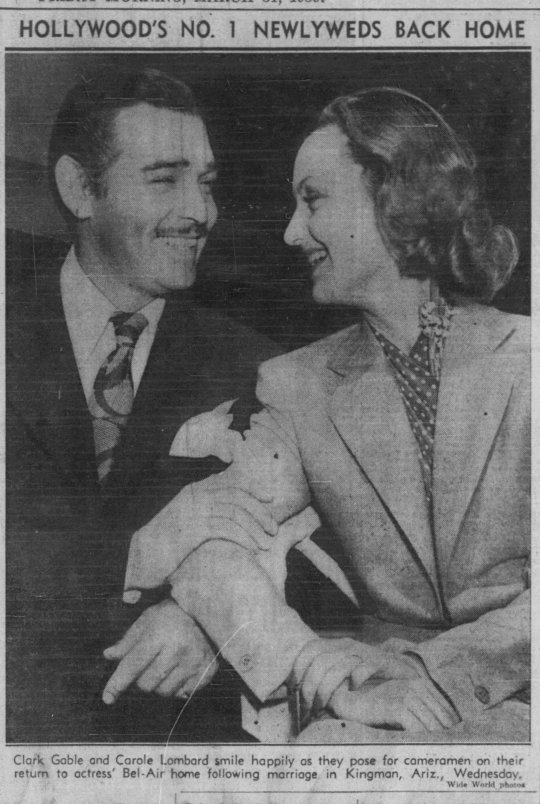
(Printed March 31, 1939 – Los Angeles Times)
Clark Gable, Carole Lombard Wed In Little Arizona Desert Town
March 30, 1939 (Associated Press)
Fun-loving Clark Gable and Carole Lombard, who wrote the long-anticipated happy ending in the story of their courtship in a little Arizona town late yesterday, returned early today to the bride’s Bel-Air home.
Exhausted by their 750-mile trip, they retired, to wait until later to move into the home on his one-mile San Fernando Valley ranch which Gable redecorated in preparation for the wedding.
Marriage Expected
Friends were not surprised when news of the ceremony reached here last night, although their absence from the film capital during the day had gone unnoticed. The marriage had been expected daily since the screen's No. 1 masculine star was given his freedom earlier this month by his second wife, Maria.
Gable, 38, and his blonde bride, 31, a top-ranking comedienne, scorned the time-tried Hollywood elopement plot. They chose Kingman, Arizona, a desert railroad community, for the rites in preference to filmdom’s more favored Gretna Greens, Yuma, Ariz., and Las Vegas, Nev. They traveled by automobile instead of by plane, as most other elopers.
They slipped in and out of Kingman so unobtrusively that only a half-dozen residents knew they were there. The license clerk, Viola Olsen, said she was so startled when she recognized them that she was almost speechless.
Directed to Parish House
After issuing the license, she directed them to the parish house of Rev. Kenneth M. Engle, pastor of the First Methodist Episcopal Church. While Miss Lombard changed from a simple traveling suit to a gray flannel ensemble, the minister quickly arranged the details.
Inside the church next door, Mrs. Engle played softly on the organ as the famous stars began their march. They walked down the aisle hand-in-hand to hear the pastor pronounce the ceremony, in which there was no word “obey.”
As each said, “I take the…” Gable slipped the ring on the actress’ finger, kissed her and they hurried out. But the news had not spread. Not a soul was waiting for them. Gable confided to Howard Cate, high school principal and one of the witnesses, that they intended to leave for Boulder City, Nev., and spend today at Boulder Dam. Then they drove away.
Dine at Needles
But a few hours later, they were eating dinner in Needles, Calif., and were reported seen in the small communities on the highway across the Mojave Desert, en route home.
They stopped briefly at a state checking station in Daggett, where an inspector said Gable was sleeping soundly, Miss Lombard appeared drowsy and their companion, Otto Winkler, publicity man, was driving.
Gable was due back on the Selznick lot today to continue work as Rhett Butler in “Gone with the Wind.” Friends said the couple expected to defer a honeymoon until summer, when both are free of picture engagements.
Gable’s ranch, with his comfortable home, was purchased some months ago. He has spent almost all his spare time there, doing some plowing and helping fare for his citrus grove.
Like “Gags”
For four years, he and Miss Lombard have been indulging in “gags” at the other’s expense. Carole’s latest was the gift of “Bessie,” a mule, to Gable on his birthday last month. “Bessie” is a favored resident of the ranch.
Once she gave him an old model T Ford for a Valentine’s gift, and he responded by parking a fire engine on her front lawn. When he gave what she considered a good performance, she sent him a ham with his picture on it. The actress, who delights in the “screwball” roles she made popular first in “My Man Godfrey,” once arrived at a party given by John Hay Whitneys in an ambulance, pretending she was ill. Gable paid her marked attention throughout the evening.
Meet In Picture
They first met in 1932 in a picture, and socially at a party a year later. Since 1935, when Gable and Maria Gable separated, they have been frequent companions at film affairs. Meanwhile he and his wife had made a mutual agreement not to meet publicly, to avert embarrassment.
The second Mrs. Gable was granted a divorce March 7, in Las Vegas. Gable earlier reached a property settlement involving $286,000 with her.
Miss Lombard, whose real name is Jane Peters, was married to actor William Powell in 1931, and divorced him in 1933.

(Printed March 31, 1939 – Daily News)
Romantic Gable Turns Shy as He and Carole Are Wed
March 30, 1939 (INS)
The Encino home of screen hero Clark Gable today welcomed the return of Gable and his new bride, Carole Lombard, blond screen beauty, whom he married late yesterday in a surprise elopement to Kingman, Ariz.
It was an elopement that left the film colony buzzing with excitement, although it was a foregone conclusion the popular film pair was to be married shortly.
Gable, recently divorced in Nevada by his second wife, and Miss Lombard had been watched constantly by reporters since Gable was divorced.
Yesterday, with practically all the writers in San Francisco for a picture premiere, the vigilance was let down.
So Clark and Carole hopped into Gable’s white roadster, picked up Otto Winkler, a studio representative, and departed for Kingman.
At dusk, in the Methodist church of Rev. Kenneth Engle, with Winkler, Mrs. Engle and Howard Cate, Kingman High School principal, as witnesses, the long-publicized romance of the two famous stars was culminated.
Viola Olsen, county clerk at Kingman, revealed the romantic Gable and the glamorous Carole were very shy indeed when they appeared before her and asked for a marriage license.
Gable grinned and said:
“I’m Clark Gable. I’d like to get a marriage license.”
He gave his age as 38. Miss Lombard said she was 29, and an actress.
Gable, Miss Olsen said, timidly asked her to recommend a minister and the clerk suggested Rev. Engle. Then Miss Olsen drove the couple to the minister’s home.
The young minister called in his wife, and went next door for Cate. Gable and Miss Lombard sat in the rectory parlor, whispering.
After the marriage service, Gable kissed his bride.
Cate said Gable, the real-life bridegroom, was not Gable, the sophisticated lover of the screen.
“They were quite lovey-dovey,” he said.
The ceremony over, Gable and Miss Lombard headed for Boulder City, Nev., where they stayed overnight, returning here today to the rambling home whose interior Carole herself arranged.
Just before leaving, however, the couple went to a phone. Mrs. Elizabeth Peters picked up the receiver in Hollywood.
“Hello, Mom, this is your new son-in-law,” Gable laughed.
Then after the bride spoke to her mother, Gable turned reporter and called the Metro-Goldwyn-Mayer press bureau in Hollywood to give details of the wedding.
It is the second marriage for Miss Lombard, who divorced actor William Powell, and the third marriage for Gable.

(Printed March 31, 1939 – Daily News)
Gables Back At New Love Nest
March 31, 1939 (INS)
Back at the bride’s smart Bel-Air home after their elopement to Kingman, Ariz., Clark Gable and Carole Lombard bubbled with excitement today as they received countless congratulations and visits from well wishers.
“Honest, “Clark explained, “it was just on the spur of the moment. I found out Tuesday night I wouldn’t have to work Wednesday and Thursday, so I called Carole and we decided to leave on Wednesday morning.”
With the nation’s No. 1 screen hero scheduled to be back to work today, the honeymoon will have to be deferred until his new picture “Gone with the Wind” is finished.
“But then we’ll go some place for a real honeymoon,” they said.
The Gables’ new love nest cottage in San Fernando valley is practically ready for occupancy, they said, and then added that it was nothing pretentious – just seven rooms.
“And one of them is going to be a gun room for Clark,” said his beaming bride, herself an actress of renown.
Discussing the marriage in Kingman, they revealed that there was no difficulty about producing the wedding ring when they stood up before Rev. Kenneth Engle in the First Methodist Episcopal Church.
“I’ve had this ring in my pocket for two months,” said Gable. “We weren’t sure when we would be able to get married because of the picture and I didn’t want to be caught unprepared in case the chance came.”
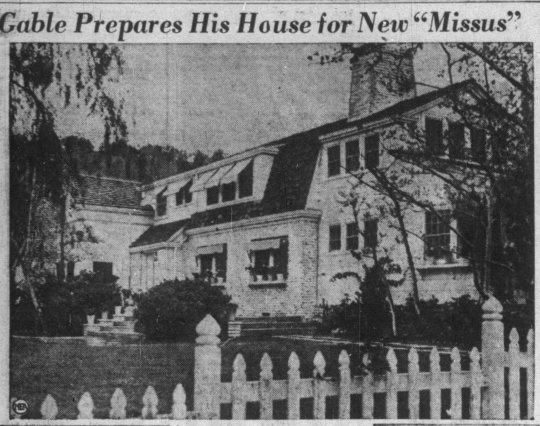
(Printed March 31, 1939 – Berkshire Evening News)
Gables Pack Up To Go To “Ranch”
March 31, 1939 (AP)
Clark Gable and Carole Lombard returned from their 725-mile wedding jaunt at 4 o’clock this morning, slept a few hours and were up at noon, looking fresh and happy, to receive photographers and reporters.
They were “at home” at Carole’s house, but there was evidence in every room that they will move soon. Dishes and pictures have been packed and Carole said she was moving to Clark’s little ranch house in about a week.
“You’ll have to put the word ranch in double quotes,” laughed Gable. “It’s only 14 acres. But we like it, don’t we honey? I plowed it personally and Carole did the interior decorating.”
The “ranch,” about 15 miles from Hollywood, boasts a mule, a hand tractor, walnut trees, and chickens. The house is Dutch colonial, seven rooms. It has two bedrooms. The servants’ quarters are over the garage.
Mr. Gable is to resume making love to Vivien Leigh, his leading lady, at 9 a.m. tomorrow.

(Printed March 31, 1939 – Tampa Tribune)
Honeymoon of Gables On “As and If” Basis
March 31, 1939 (United Press)
Clark Gable, who performs more gracefully as a lover on the screen than off, diffidently put his arm around the slim waist of Carole Lombard, his bride, today and said yes, he was a lucky guy. She had just called him the star in their family.
The newlyweds drove until 3 a.m., after their elopement to Kingman, Ariz., yesterday, slept for a few hours, and emerged from Miss Lombard’s torn-up house as fresh as a couple of daisies – well, almost as fresh – to say their honeymoon was on a when, as, and if basis.
The widely-grinning Gable, clad in a slightly rumpled blue serge suit, badly needed a haircut. That was the rub. He has to have his hair long for his part in “Gone with the Wind” and it’ll be two months before that job is finished.
Plans Indefinite
“And on Wednesday I go to work at RKO,” his bride said, “and it looks as it our plans for a honeymoon will heave to be indefinite as they were for our marriage. Only reason we got married yesterday was because Clark suddenly found he’d have the day off.”
“That’s true,” chimed in Carole’s mother, the wealthy Mrs. Elizabeth Peters. “I certainly was surprised when they called me up and swore me to secrecy.”
As for widely-printed reports that Miss Lombard intends to stop earning $425,000 a year as one of the movie’s top stars and become a housewife and maybe have some children, she smiled and said that was more guesswork.
“Eventually,” she said, “I’m going to retire, but that’s all in the future and I haven’t thought about it much. It’s too far away. But I can say now that Clark is the star of the family. He always has been.”
Have Pictures Taken
While his bride did the talking, Gable tried to follow the orders of a dozen directors, in the form of news cameramen, all shouting at once. Some wanted him to squeeze his wife, others wanted him to put his head next to hers as if about to bestow a kiss, while the rest insisted that the bride and groom walk arm-in-arm from the front door of Miss Lombard’s white brick house.
All this artistic work was accomplished in good time. Gable and his bride are old hands at having their pictures taken. When the last flash bulb was exploded, they invited everybody inside to drink to their happiness.
This took some doing, because all of the bride’s highball glasses were wrapped in old newspapers and packed in barrels. The catering department of the Brown Derby drove up about then, though, and all hands had a spot of Scotch and soda.
Miss Lombard had packed all her furniture on the theory that Gable’s new ranch home in San Fernando valley would be ready, but the plasterers still had not finished their work.
“So I had a few chairs and things unpacked again,” she said, “and we’ll stay in this house until our new one is ready. I think it’ll be about two weeks more.”
4 notes
·
View notes
Text
Pete Seeger (1919-2014) We shall Overcome (Sheet Music)
Pete Seeger - We shall Overcome (arr. for Quartet with lyrics + guitar chords) sheet music
https://dai.ly/x8fhsg4

“No one can prove how important music is, but people in power believe it is, and they try to control it,” Pete Seeger (b. May 3, 1919) wrote in 2010 as the Foreword to the children’s book We Shall Overcome: A Song That Changed the World. “The power of singing together shows us that change is possible. In Beacon, New York, where I live, adults and children gather every year for a big block party called ‘The Spirit of Beacon Day.’ There are people from different religions and different cultures, speaking many different languages. There is singing, dancing, and eating. It is a hopeful event for everyone and music helps to bring us together.” This approach gives a good sense of one of the central threads in Seeger’s long, complex public life—his optimism and promotion of folk singing throughout the world—which we have tried to capture through the discussions and documents in The Pete Seeger Reader. It has been a life filled with triumphs and pitfalls, but throughout he has struggled to be primarily a teacher as well as a performer and political organizer. In 1991 Pete journeyed to Havana, Cuba, to receive that country’s highest award, the Felix Varela Medal. Three years later, President Bill Clinton bestowed on him the National Medal of the Arts as well as a Kennedy Center Award during a nationally televised ceremony in the nation’s capital. In 1996 Pete was inducted into the Rock and Roll Hall of Fame in Cleveland, the same year that his CD Pete garnered a Grammy Award for Best Traditional Folk Album. Three years earlier, he captured a Grammy Lifetime Achievement Award. The Grammy Awards kept coming, in 2009 with At 89, also for Best Traditional Folk Album, then two years later when Tomorrow’s Children captured honors for the Best Musical Album for Children. As Pete had come from a long line of New England aristocrats—his father, Charles, was a gifted musicologist who had pioneered the field of ethnomusicology, and his mother, Constance de Clyver Edson, was a talented violinist—and had attended Harvard College, such awards might have seemed natural and fitting. But this was not always the case. Pete had dropped out of Harvard during his second year, 1938, and never looked back. For the next seven plus decades he would follow his muse—the banjo, folk music, and activist politics—in the process becoming the country’s (even the world’s) most famous folk performer as well as political activist. The road, however, was a rough one. The basic outlines of Pete’s story have been told, particularly by his biographer David King Dunaway, in How Can I Keep from Singing? The Ballad of Pete Seeger (first published in 1981, then expanded and updated in 2008). Two shorter biographies have also appeared: Allan M. Winkler, “To Everything There Is a Season”: Pete Seeger and the Power of Song (2009) and Alec Wilkinson, The Protest Singer: An Intimate Portrait of Pete Seeger (2009). Jim Brown’s wonderful documentary film, Pete Seeger: The Power of Song (Genius Products, 2008), captures much of the story. David King Dunaway’s three-hour radio series Pete Seeger: How Can I Keep from Singing? is also helpful. Dunaway has cataloged, as much as possible, Seeger’s amazing list of recordings in A Pete Seeger Discography: Seventy Years of Recordings (2010). Pete has not only recorded hundreds of folk songs, old and new, foreign and domestic, but also the Folkways albums The Nativity, Traditional Christmas Carols, and Jewish Children’s Songs and Games, as well as the Phillips release The Birth: Story of the Nativity by Scholem Asch. As for Seeger’s own writings, he has published various editions of Where Have All the Flowers Gone: A Singalong Memoir, starting in 1993, the latest in 2009, which includes much autobiographical information as well as the lyrics to hundreds of his songs. We have, therefore, included no song lyrics. Many of his pre-1970 writings were collected and published by Jo Metcalf Schwartz, ed., in The Incomplete Folksinger by Pete Seeger (1972), including his columns for Sing Out!, titled “Johnny Appleseed, Jr.,” which began in the fall 1954 issue: “This column is dedicated to Johnny Appleseed, Jr.,—the thousands of boys and girls who today are using their guitars and their songs to plant the seeds of a better tomorrow in the homes across our land …. For if the radio, the press, and all the large channels of mass communication are closed to their songs of freedom, friendship and peace, they must go from house to house, from school and camp to church and clambake.” Most recently, Rob Rosenthal and Sam Rosenthal have edited Pete Seeger in His Own Words (2012), a broad collection of his writings, many previously unpublished and drawn from Pete’s private collection. In November 2002 Pete wrote me (Ron Cohen) a letter, commenting on my book Rainbow Quest: The Folk Music Revival and American Society. 1940–1970 (2002). After some initial comments, mostly positive—“I learned a lot of things I never knew. And of the things I knew, I believe you got a B+, sometimes an A+”)—he helpfully concluded: “I’m sorry you didn’t give more space to women: Malvina , Holly Near, & my stepmother Ruth. And Faith Petric! … The steady (if slow) proliferation of clubs, publications, venues (including festivals), songwriters, & home music is THE important thing, and not the fame or fortune of us professionals! Not that the latter are unimportant. Arlo Guthrie and ‘City of New Orleans’ have inspired millions, I believe.” For someone who has been in the public eye since 1939, he had a telling point, but it is consistent with Seeger’s lifelong pursuit of being an educator, as well as his success as an entertainer, songwriter, and political activist. His organizing skills began with the formation of the Almanac Singers in 1941, continued after the war with People’s Songs and People’s Artists, the Weavers in 1949, then Sing Out! in 1950, the Newport Folk Festivals beginning in 1959, Broadside magazine in 1962, and the launching of the Clearwater sailing ship and environmental movement in 1969. All the while, music was interwoven with his strenuous promotional and educational activities. We have chosen the selections in this book to focus on materials written about Seeger and we drew upon a number of rather obscure publications. The number and rich variety of magazines in the United States (and throughout the world) where interviews and articles have appeared is certainly amazing and perhaps matched only by a few other popular musicians (such as the Beatles, Elvis, and Bob Dylan)—Rolling Stone, Goldmine, Life, Songwriter, Pickin’, FRETS, Saturday Review, Acoustic Guitar, not to mention Sing Out! and other folk publications, even the men’s magazine Penthouse, as well as dozens of newspapers and other publications. We have included a smattering of interviews coming up to 2010, but they are rather redundant, often repeating the same background stories and political views, with, of course, variations. Seeger has been a prolific writer, and some of his more interesting and insightful essays have been included, particularly demonstrating the development of his ideas and interests over the many decades. For example, by the 1960s he became increasingly concerned about the cultural role of television, during and after his blacklisting from the mainstream media. At the same time he created Rainbow Quest, thirty nine folksy TV programs, 1965–1966, for WNJU, Newark, New Jersey’s, educational channel, which began by featuring Tom Paxton along with the Clancy Brothers and Tommy Makem. There followed an amazing array of performers, old and new friends, such as Elizabeth Cotten, Malvina Reynolds, Doc Watson, Mimi and Richard Fariña, Johnny Cash, Roscoe Holcomb and Jean Redpath, Donovan and the Rev. Gary Davis, Sonny Terry and Brownie McGhee, and Buffy Sainte-Marie. The series appeared after ABC-TV blacklisted him from appearing on the popular Hootenanny show, a flap that garnered much publicity. Clearwater Publishing later issued thirty-eight shows on tape, and most recently Shanachie included twelve episodes on six DVDs. Along with his multitude of recordings and books, Seeger has also produced numerous films to inform and instruct. For example, he starred in a short film in 1946, To Hear Your Banjo Play, which also included Woody Guthrie, Baldwin “Butch” Hawes, Sonny Terry, Brownee McGhee, and Texas Gladden. During the family’s world trip in 1963 the camera was continually rolling. In 2006 Vestapol released the fascinating DVD A Musical Journey: The Films of Pete, Toshi, & Dan Seeger, 1957– 1964. Pete Seeger is perhaps most proud of his children’s songbooks, beginning with Foolish Frog (1973), followed by (with Paul Dubois Jacobs) Abiyoyo (1985), Pete Seeger’s Storytelling Book (2000) Pete Seeger’s Abioyo Returns (2001), Some Friends to Feed: Stone Soup (2005), and The Deaf Musicians (2006). There are also the political songbooks, including Hard Hitting Songs for Hard Hit People (1967), Songs for Peace (1966), and ending with Everybody Says Freedom (1989) and Carry It On! The Story of America’s Working People in Story and Song (1985), both with his collaborator Bob Rieser. In addition to Where Have All the Flowers Gone, he has produced numerous other songbooks and instruction manuals, including the influential How to Play the 5- string Banjo (1948 and subsequent editions), How to Make a Chalil (1955), Choral Folksongs of the Bantu for Mixed Voices (1960), American Favorite Ballads (1961), The Goofing Off Suite (1961), The Steel Drums of Kim Loy Wong (1961), Woody Guthrie Folk Songs (1963), The Bells of Rhymney (1964), Bits and Pieces (1965), Oh Had I a Golden Thread (1968), Pete Seeger on Record (1971), and Henscratches and Flyspecks: How to Read Melodies from Songbooks in Twelve Confusing Lessons (1973). Seeger’s life has been a roller-coaster ride, with his left-wing politics often generating much heat. Many of our selections, which follow roughly a chronological progression, highlight his more than seven-decade struggle between popularity and vilification. Yet, all the while, Seeger continued his amazing productivity and influence. Most of the selections have been previously published, but not all. There are also excerpts from foreign publications, all in English, since he has been a world figure, with his recordings issued in dozens of countries. We have not included the profusion of articles from the New York Times since they are readily available. “Pete Seeger is possessed of that rarest of human qualities—the inquiring mind,” his old friend Alan Lomax has written. “This gentle and at the same time fiery and unbeatable spirit pervades his music, his friendships, his beanpole body and his thought. Hisperformances are true to our folk music traditions. He has listened with a keen ear and uses the singing and instrumental styles of our folk musicians faithfully and sensitively” (Notes for Pete Seeger concert program, Her Majesty’s Theatre, Montreal, Canada, May 13, 1962). Seeger has been a tireless champion of folk and popular music—he has never referred to himself as a “folk singer,” but rather “a singer of folk songs”—which we have tried to capture in the selections that follow. He has also been a political activist, first a crusader for socialism, labor unions, civil rights, and world peace (except during World War II), then during and following the 1960s of restoring the environment, not as a substitute for his earlier passions but rather as a compliment and addition. He has given thousands of concerts around the world, always as a tireless champion of music as well as various political causes, but he has also done so much more as a teacher, author, filmmaker, and organizer. For the latest information, check out the website www.peteseeger.net. We have not corrected factual errors in the essays, except in rare cases, but we are aware that they do exist. There are also spelling discrepancies, for example, Leadbelly instead of the correct Lead Belly. Read the full article
0 notes
Text
hey have you guys ever seen An American Christmas Carol (whose star I have met) starring Henry Winkler (who I have met) where the character played by Henry Winkler (who I have met) is the American version of Scrooge, Benedict Slade (played by a man I have met) who's played by the same actor (who I have met) even in the past because for the present they put old guy makeup on Henry Winkler (who I have met)
2 notes
·
View notes
Photo



An American Christmas Carol (Eric Till, 1979)
11 notes
·
View notes
Photo

027
#gay#gay people#people#nureyev is valentino#nureyev#valentino#rudolf nureyev#leslie caron#michelle phillips#carol kane#ken russel#harry benn#irwin winkler#robert chartoff#film#filme#anos 70#70s
1 note
·
View note
Text
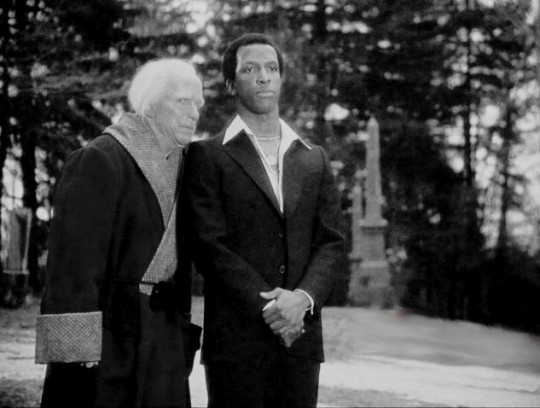
Henry Winkler as Benedict Slade and Dorian Harewood as Matt Reeves in "An American Christmas Carol"
7 notes
·
View notes
Text
Movie Theater Time Machine podcast continues the Christmas season with a review of “An American Christmas Carol". Find the new episode at the link or on your fav catcher at https://linktr.ee/Mttm
#MTTimeMachine#4041Media#moviereview#filmreview#podernfamily#podbean#podcast#movie#film#itunes#movie review#review#christmas movies#christmas movie review#christmas carol#henry winkler#tv movie#70s movies#1970s movies#holiday movies
1 note
·
View note
Text



W A T C H I N G
#AN AMERICAN CHRISTMAS CAROL (1979)#HENRY WINKLER#Eric Till#Dorian Harewood#Susan Hogan#Cec Linder#R.H. Thomson#David Wayne#Michael Wincott#William Bermender#Brett Matthew Davidson#Tammy Bourne#Chris Cragg#Arlene Duncan#Gerard Parkes#CHARLES DICKENS#A CHRISTMAS CAROL#WATCHING#CHRISTMAS MOVIE#PERIOD FILM#ADAPTATION#GHOST STORY
1 note
·
View note
Text
So Weird/The Office/Hallmark
I’m working on a Christmas-focused So Weird playlist.
Henry Winkler tweeted about An American Christmas Carol - a movie he did after Happy Days.

I already knew of his Hallmark movie The Most Wonderful Time of the Year, but this year I learned of Jewel Staite’s version of Call Me Mrs. Miracle.
Y’all that movie is difficult to find online! The DVD prices are all over the place. And while looking for a stream to rent I noticed the director of the movie is MICHAEL SCOTT?!

After I gave up looking for that Hallmark movie I checked for Wonderful Time of the Year and noticed something:

Besides the fact that this movie is older than Mrs. Miracle but available in great quality, it was directed by the same person.
Apparently this guy - Michael Scott - has been making TV movies since the 80s, started making Hallmark Christmas movies before they became what they are now, AND the dude is still making Hallmark movies!
Way to go, Michael Scott. How does it feel working with So Weird cast members and executive producers?

Anyway, I’ll post the playlist soon and if someone has a copy of Call Me Mrs. Miracle (2010) to share so I can add it to the playlist I’ll be forever grateful.
#remember that scene in office space when michael bolton is like why should i change my name he's the one that sucks?#i wonder if michael scott thought that when he heard about the office#because YOU KNOW he must get second looks and laughs whenever he introduces himself nowadays#so weird#disney so weird so weird disney#henry winkler#jewel staite#steve carell#call me mrs. miracle#michael scott#hallmark#hallmark movies#hallmark christmas movies#christmas movie review#the most wonderful time of the year#an american christmas carol
3 notes
·
View notes
Photo










And 10 more Scrooges, all from TV, to celebrate A Christmas Carol, originally published in 1843: Patrick Stewart, 1999, Mister Magoo (Mr. Magoo’s Christmas Carol,) 1962, Cicely Tyson (Ms. Scrooge,) 1997, Kelsey Grammer, 2004, Henry Winkler (An American Christmas Carol,) 1979, Fred Flinstone (A Flinstone’s Christmas Carol, 1994, Michael Horden, 1977, Oscar the Grouch, 2006, Rowen Atkinson (Blackadder’s Christmas Carol,) 1988, Frederic March, 1954.
#books#a christmas carol#charles dickens#christmas#televion#tv#sesame street#patrick stewart#television adaptation#cicely tyson#kelsey grammer#frederic march#oscar the grouch#fred flintstone#michael hordern#bbc#henry winkler#rowan atkinson#blackadder#mister magoo
11 notes
·
View notes